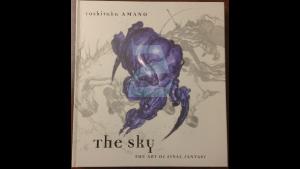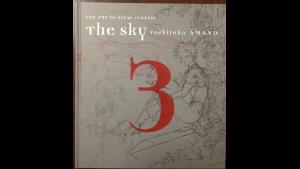The Sky: The Art of Final Fantasy Review
December 13, 2012 Over ten years after its original Japanese release, The Sky: The Art of Final Fantasy hit North American shores courtesy of Dark Horse in October. This incredibly limited-edition artbook features artwork from the first ten Final Fantasy titles. Rob managed to snag one of the 1,000 released, and below are his thoughts.
 I spend a lot of my time at RPGFan complaining about the current state of the Final Fantasy series. My animosity comes from a deep seeded sense of nostalgia and longing to see the franchise return to greatness. While each FF installment features an individual sense of personality, they all used to share some common elements. Chief among these connecting threads, in my opinion, was the artwork of Yoshitaka Amano, an artist whose watercolor styling and intricate design jelled incredibly well with the static backgrounds and characters of the 8 and 16 bit games. It's been rather difficult to get a hold of Amano's work outside of Japan, but that's all changed thanks to a wonderful anthology released by Dark Horse Comics.
I spend a lot of my time at RPGFan complaining about the current state of the Final Fantasy series. My animosity comes from a deep seeded sense of nostalgia and longing to see the franchise return to greatness. While each FF installment features an individual sense of personality, they all used to share some common elements. Chief among these connecting threads, in my opinion, was the artwork of Yoshitaka Amano, an artist whose watercolor styling and intricate design jelled incredibly well with the static backgrounds and characters of the 8 and 16 bit games. It's been rather difficult to get a hold of Amano's work outside of Japan, but that's all changed thanks to a wonderful anthology released by Dark Horse Comics.
The Sky: The Art of Final Fantasy represents possibly the largest collection of Amano's art for the franchise to date. Spanning three hardcover books, Dark Horse takes us on a wonderful journey through the history of Final Fantasy. Each of the first ten games gets a section, and you won't believe just how much Amano contributed to the franchise. Starting with the character designs, it's easy to think that Amano's heroes look relatively similar. The androgynous eyes and chins of the main protagonist for each game is public knowledge , but Amano exhibits a great deal of creativity with almost every character. The peripheral characters (think Strago from six or XDeath from four) have such radically different features that one could assume they came from different artists. Costume and armor design also helps to give each character a strong sense of place and standing. The use of color for each character is striking and helps to better distinguish each individual. This was critical during the pre-polygon days of the franchise, as the difference between blue and red would help the player quickly identify key characters.
 Amano is probably best remembered in America for the Final Fantasy logos. His design process for these iconic moments and images is a separate piece of the collection, contained in a short interview accompanying photos of Amano's exhibits in New York City. It's unfortunate that Amano's role in the franchise has been diminished to the logo seen before the actual game takes shape. Amano recently mentioned that he forgot about all of the work he did on Versus-13's logo, which is probably a telling sign.
Amano is probably best remembered in America for the Final Fantasy logos. His design process for these iconic moments and images is a separate piece of the collection, contained in a short interview accompanying photos of Amano's exhibits in New York City. It's unfortunate that Amano's role in the franchise has been diminished to the logo seen before the actual game takes shape. Amano recently mentioned that he forgot about all of the work he did on Versus-13's logo, which is probably a telling sign.
But Amano wasn't limited to character and logo designs. I think few fans realize just how many monsters and enemies came from the mind of this amazing artist. Seeing the original drafts for Final Fantasy staples like the bomb and moogle probably shows Amano at his absolute best. Each creature brims with life and character, and very little was lost when transplanting these static images into sprites. Square moved away from Amano's monster and character design when transitioning to the PSOne, and I can't really argue with the theory. The low polygon count wouldn't have done justice to Amano's vision, so the decision to switch to Tetsuya Nomura's more anime-inspired styling was probably a good one. Amano did create some artwork based around Nomura's character designs in seven and eight, and his interpretations are certainly intriguing. The famous dance scene from eight, for example, looks stunning and ethereal when viewed through Amano's lens.
 There are a fair number of "action" shots in Amano's collection that help to shape the nature of the characters and events. The original Four Warriors of Light standing up against evil is probably the most well known from the NES era, but the PSOne moments probably stand out the most for me. Cloud and Aeris sharing a quiet moment establishes their (rather odd) relationship, while Zidane defending Garnet from a monster emphasizes his desire to protect the group. Some of these paintings never made it into a game, which is a shame considering how much they add in terms of complexity and character.
There are a fair number of "action" shots in Amano's collection that help to shape the nature of the characters and events. The original Four Warriors of Light standing up against evil is probably the most well known from the NES era, but the PSOne moments probably stand out the most for me. Cloud and Aeris sharing a quiet moment establishes their (rather odd) relationship, while Zidane defending Garnet from a monster emphasizes his desire to protect the group. Some of these paintings never made it into a game, which is a shame considering how much they add in terms of complexity and character.
For me, flipping through Amano's Final Fantasy artwork was a nostalgic and heartbreaking experience. While I respect the new direction of the art design in the most recent games, I can't help but feel like they've lost a certain magic in terms of vision and execution. The city of Alexandria in nine feels more alive than any of the cacophony of nonsense going on in Cocoon or Pulse from thirteen. The personality and imagination feels lost in committee while the focus shifts towards what looks cool rather than what looks functional. Indeed, it's a similar problem facing the second Star Wars Trilogy. Filling space with incredible visual fidelity doesn't necessarily translate to form or function, leading to a passive experience and lack of wonder.
Yoshitaka Amano's work went a long way in making the characters, enemies, and environments of Final Fantasy feel tangible. My favorite piece of Amano art is Terra, atop her magiteck armor, overlooking the capital city of the empire in FF6. Everything about that world is contained in this amazing art; Terra's human qualities directly contrasting the cold and mechanical world that's encroaching on all of civilization. Amano's vision helped direct and fill in the blanks where technology couldn't initially. Art through inaction helped to give a breath of life to Final Fantasy, where explosions and exposition now try to fill in for true heart and soul. I hope that the franchise returns to the sense of world and place so quickly cast aside in favor of dynamic combat and intense action. Perhaps bringing Amano back would do the trick, but I think Square-Enix could fix a great deal of their problems if they focus on world rather than spectacle, on characters instead of set-piece action.
